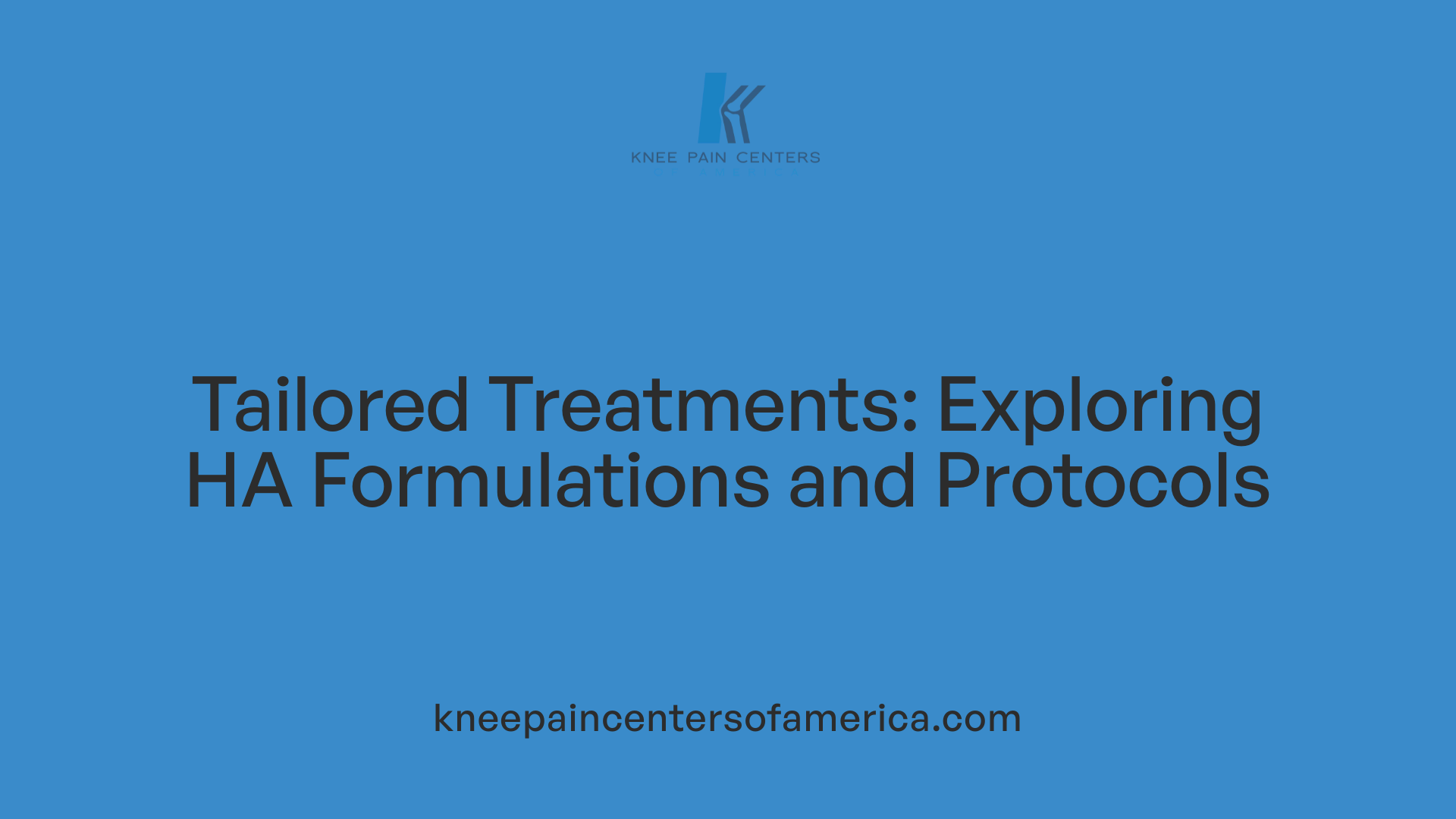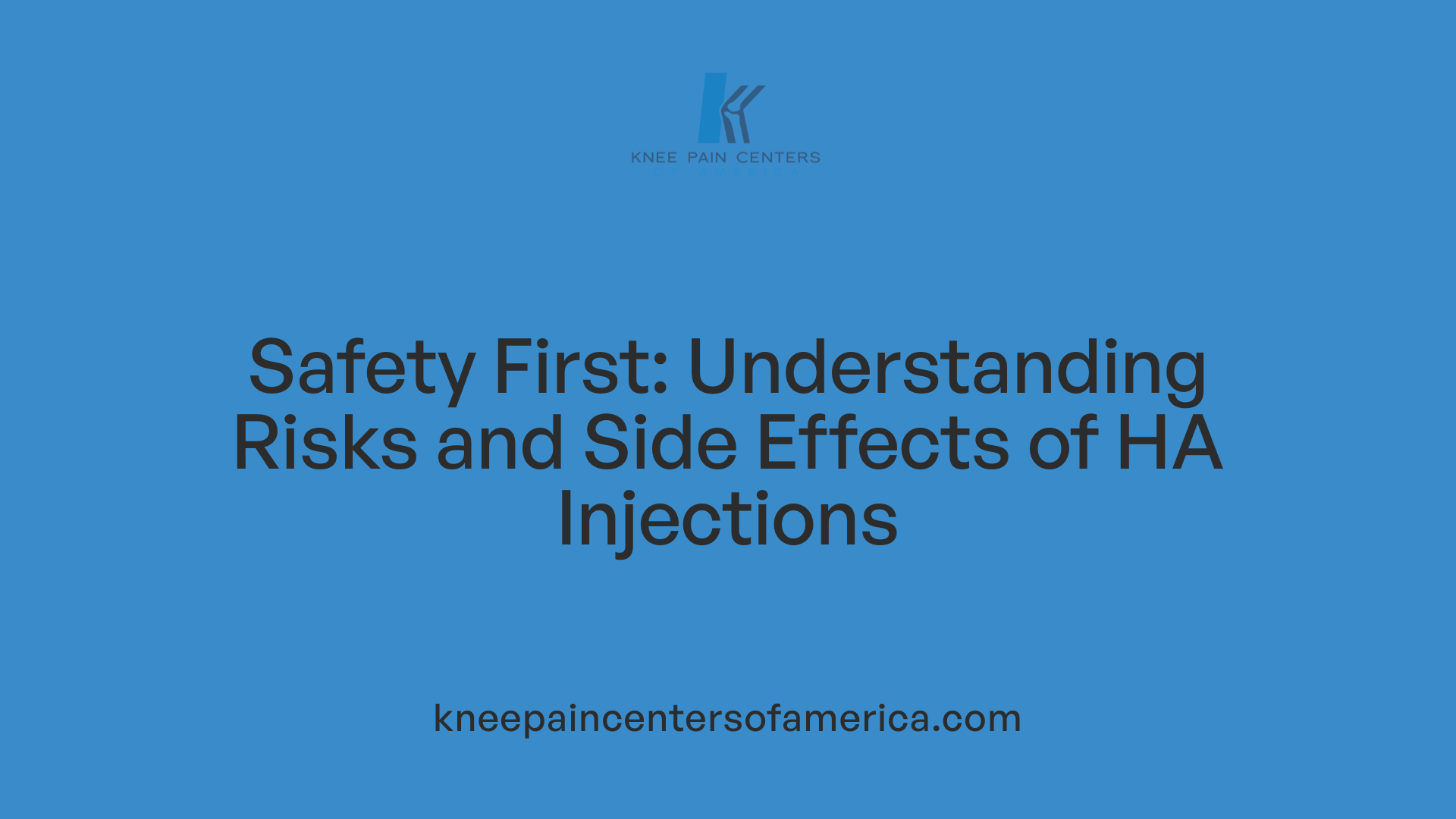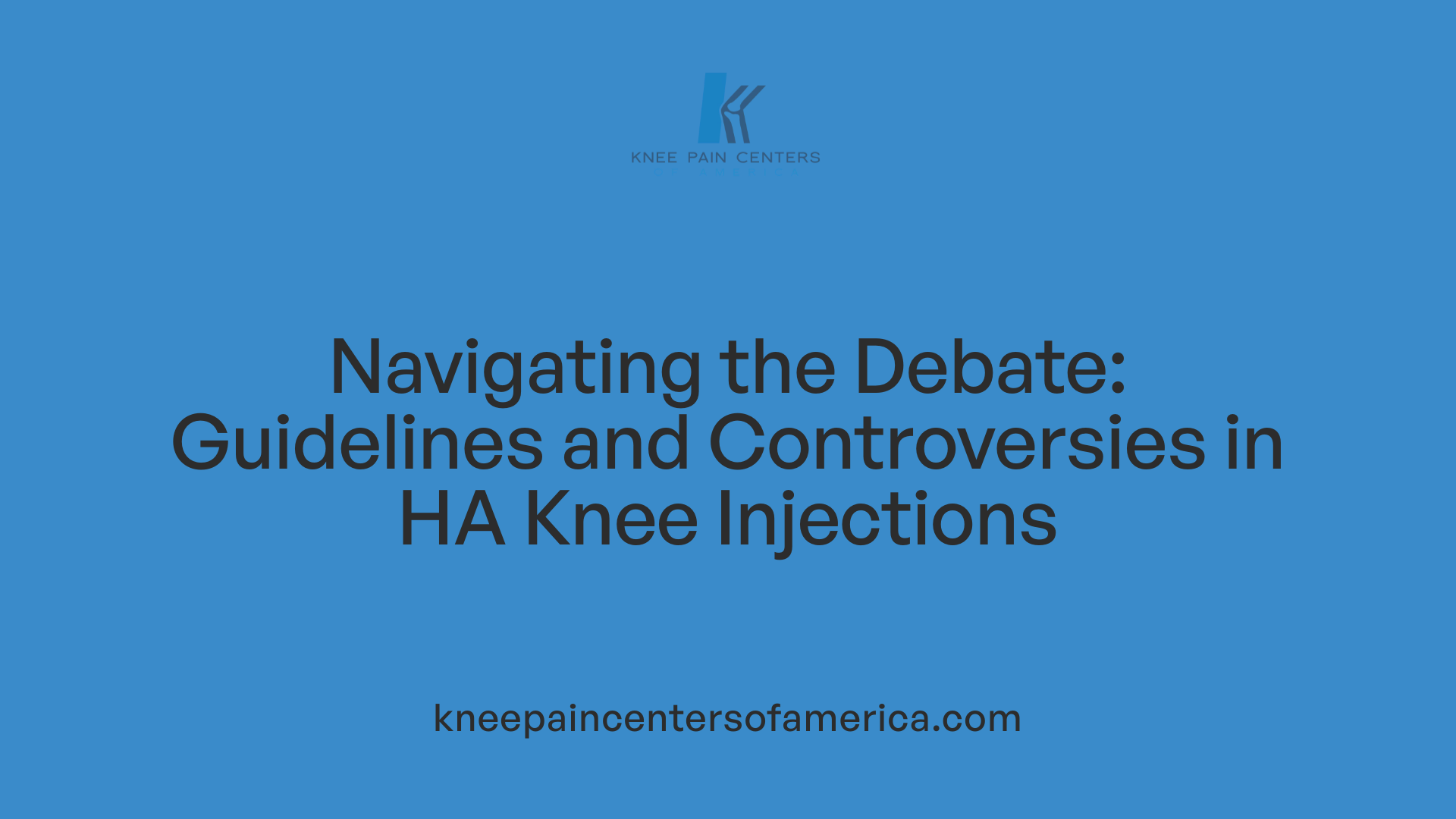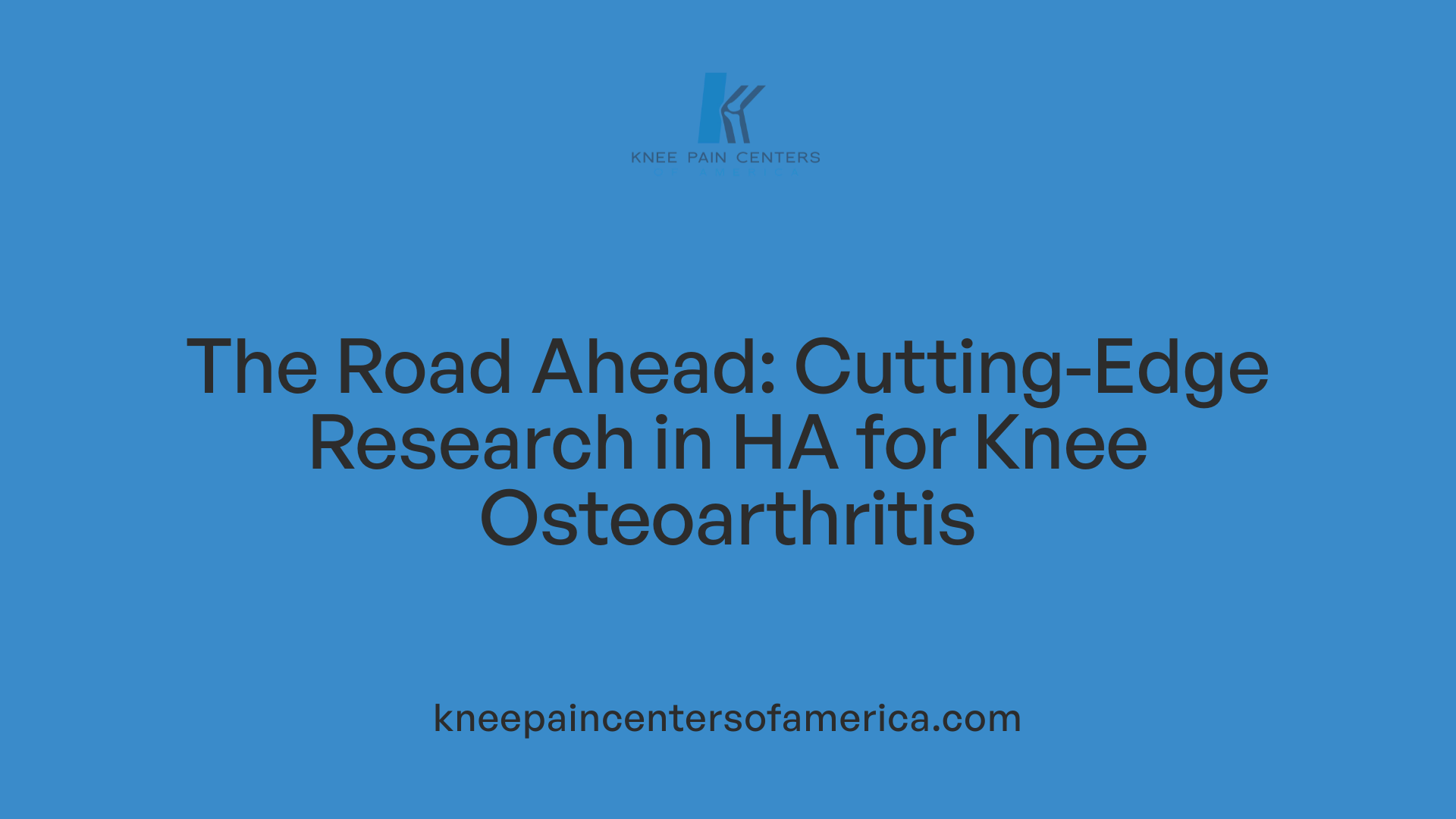Understanding Knee Osteoarthritis and Treatment Challenges
Knee osteoarthritis is a common degenerative joint disease affecting millions, characterized by cartilage breakdown, pain, stiffness, and reduced mobility. Managing symptoms can be complex, involving non-surgical options such as physical therapy, medications, and increasingly, injectable treatments. Among these, hyaluronic acid (HA) injections have gained attention for their potential to relieve pain and improve joint function by replenishing natural joint lubricants lost due to disease progression. This article delves into what HA injections are, how they work, their benefits, safety profile, and the ongoing debates surrounding their use in knee osteoarthritis therapy.
What Are Hyaluronic Acid Injections and How Do They Work?
Definition and Nature of Hyaluronic Acid
Hyaluronic acid (HA) is a naturally occurring complex sugar molecule found in the body, particularly abundant in the eyes, skin, and joints. It plays a critical role in maintaining tissue hydration and elasticity.
Role of HA in Joints
Within joints, HA acts as both a lubricant and a shock absorber, helping synovial fluid reduce friction and cushion the bones during movement. This viscoelastic property enables smooth joint function and flexibility.
How Osteoarthritis Affects HA Levels
Osteoarthritis (OA) causes a decrease in HA concentration and quality in joint fluid. This reduction contributes to increased pain, stiffness, and decreased joint movement as the cushioning and lubricating effects weaken.
Mechanism of HA Injections in Knee Joints
Hyaluronic acid injections replenish the synovial fluid’s lost viscoelasticity, aiming to reduce inflammation and improve lubrication within the knee. These injections can also form a barrier around nerve endings and reduce pain signaling. This restorative process can alleviate discomfort and improve mobility in affected joints.
Types and Sources of HA Injections
HA injections come from various sources, originally extracted from rooster combs or produced in laboratories as non-animal derivatives. They differ in molecular weight; high-molecular-weight HA tends to be more viscous and may offer enhanced therapeutic effects.
Administration Procedure and Dosing
The injections are administered directly into the knee joint by a healthcare professional, often under local anesthesia and sometimes guided with imaging such as ultrasound or X-ray. The typical regimen consists of multiple injections spaced weekly, though recent developments include single-dose injections with comparable effectiveness.
Together, these elements make HA injections a targeted treatment to restore joint function affected by osteoarthritis.
Efficacy and Clinical Evidence of Hyaluronic Acid Injections

Clinical Trial Outcomes and Pain Relief Timeline
Numerous clinical trials and systematic reviews have shown that hyaluronic acid (HA) injections offer modest but statistically significant relief for knee osteoarthritis symptoms. Patients often start experiencing pain relief approximately 4 to 6 weeks after treatment, with benefits lasting up to 6 months. A pooled analysis of 38 randomized controlled trials involving over 5,000 patients demonstrated functional improvements alongside decreased pain. These benefits appear consistently regardless of whether HA is administered as a single injection or as multiple doses.
Comparison with Placebo and Other Treatments
When compared to placebo, HA injections generally provide superior pain relief and improved joint function. Meta-analyses indicate that HA's efficacy may surpass that of NSAIDs and other conservative therapies, though some reviews highlight only slight advantages over placebo. The variability in outcomes is influenced by factors such as molecular weight of the HA preparation and injection protocols.
Potential to Delay Knee Replacement
Data from clinical studies suggest that HA injections can postpone the need for knee replacement surgery in certain patients, especially those who have inadequate responses to weight management, physical therapy, or NSAIDs. While HA injections improve symptoms and joint mobility, they do not eliminate the eventual need for surgery in advanced osteoarthritis, but they can extend the period before surgical intervention becomes necessary.
Disease-Modifying Effects
Emerging evidence points to potential disease-modifying properties of HA. Studies reveal that HA may stimulate cartilage-producing chondrocytes, reduce inflammation by downregulating pro-inflammatory mediators, and possibly affect subchondral bone remodeling. These biological activities may contribute to delayed cartilage degradation and improved joint structure, though further research is needed to confirm long-term structural benefits.
Combination Therapies Enhancing Effectiveness
Combining HA injections with other agents like corticosteroids, platelet-rich plasma (PRP), or mesenchymal stem cells has shown enhanced clinical outcomes. Corticosteroid combinations tend to provide quicker symptom relief, whereas PRP or stem cell augmentation may result in more sustained improvements. These combination approaches demonstrate promise in maximizing HA therapeutic benefits beyond its use as a standalone treatment.
Variations in Hyaluronic Acid Treatments and Injection Protocols

What types of hyaluronic acid injections are available?
Hyaluronic acid (HA) injections come in several forms that vary by source and molecular weight. Some are animal-derived, originally sourced from rooster combs, while others are synthetically produced in laboratories. The molecular weight, which affects the viscosity of the product, ranges from low to high; higher molecular weight HA tends to be thicker and potentially more effective in lubricating and cushioning the knee joint.
Common FDA-approved brand names include Synvisc, Synvisc-One, Euflexxa, Orthovisc, Hyalgan, Supartz FX, and Durolane. These products differ not only in their molecular characteristics but also in their injection schedules, typically requiring between one and five injections spaced about a week apart.
How are hyaluronic acid injections administered?
HA injections are performed by healthcare providers such as orthopedic surgeons, sports medicine doctors, or physiatrists. The procedure typically involves injecting HA directly into the knee joint, usually following local anesthesia to minimize discomfort. Imaging techniques like ultrasound or X-ray guidance can be used to ensure precise needle placement.
Traditionally, patients receive multiple injections, often weekly over a period of three to five weeks, to replenish the synovial fluid and restore joint function. Recently, single-dose HA formulations have been FDA-approved, showing comparable effectiveness and offering a more convenient option for patients.
Off-label uses and emerging options
While HA injections are specifically FDA-approved for knee osteoarthritis, some clinicians use them off-label in other joints such as the ankle, shoulder, and thumb. Emerging formulations combine HA with substances like corticosteroids or platelet-rich plasma (PRP) to enhance therapeutic effects. Research continues to explore these options for improved symptom relief and potential disease modification.
| Aspect | Details | Notes |
|---|---|---|
| Sources | Rooster comb-derived, synthetic | Animal-derived products may not suit bird-allergic patients |
| Molecular Weight | Low to high | High molecular weight = more viscous, potentially more effective |
| Injection Protocol | 1 to 5 weekly injections or single-dose lately approved | Single-dose offers convenience with similar efficacy |
| Common Brands | Synvisc, Euflexxa, Orthovisc, Hyalgan, Supartz FX, Durolane | Vary in molecular weight and injection schedule |
| Administration | Local anesthesia, imaging guidance (ultrasound/X-ray) | Usually done in-office by specialists |
| Off-label and emerging | Use in other joints; combination with corticosteroids, PRP | Under ongoing study for enhanced outcomes |
Safety Profile and Potential Side Effects of Hyaluronic Acid Injections

Are hyaluronic acid injections safe?
Hyaluronic acid (HA) injections have a well-established safety profile, making them a relatively low-risk treatment option for knee osteoarthritis. Most patients experience only mild and temporary side effects such as localized pain, swelling, redness, or mild inflammation at the injection site. These reactions typically resolve on their own within a short period.
What are the common mild side effects?
The most common side effects include:
- Temporary discomfort or pain at the injection site
- Mild swelling or redness
- Mild local inflammation These effects usually subside without the need for further treatment.
Are there any rare but serious complications?
Although very uncommon, some patients may experience serious adverse reactions such as:
- Pseudoseptic arthritis, characterized by severe pain, swelling, and inflammation that mimics infection
- Severe allergic reactions Such complications require immediate medical evaluation and intervention.
Who should avoid HA injections?
Contraindications for HA injections include:
- Known allergies to hyaluronate formulations or bacterial proteins used in the preparations
- Active infections in the joint or surrounding skin
- Systemic infections such as bacteremia
- Pediatric patients Patients should also avoid strenuous activities for at least two days post-injection to reduce risks.
How do HA injections compare with other injectable treatments?
Compared to corticosteroid injections, HA injections generally have fewer serious side effects and may exert chondroprotective effects, potentially slowing arthritis progression. HA injections tend to cause less tissue damage and are considered safer for patients with certain health conditions.
How are adverse reactions managed?
Mild side effects typically require no specific treatment and resolve spontaneously. For rare severe reactions, patients need prompt medical attention. Proper patient selection and adherence to procedural precautions help minimize complications.
| Aspect | Details | Notes |
|---|---|---|
| Common side effects | Pain, swelling, redness, mild inflammation | Usually transient and self-limited |
| Rare complications | Pseudoseptic arthritis, severe allergic reactions | Require immediate treatment |
| Contraindications | Allergies, infections, bacteremia, pediatric use | Critical for patient safety |
| Precautions | Avoid strenuous activity post-injection; no disinfectants with quaternary ammonium salts | Enhances injection effectiveness |
| Comparison with corticosteroids | HA has fewer serious side effects; possible chondroprotective effects | Preferred in certain patient populations |
Controversies and Guidelines Surrounding HA Injections for Knee Pain

What do medical guidelines say about hyaluronic acid injections for knee osteoarthritis?
Medical guidelines show significant divergence in their stance toward hyaluronic acid (HA) injections for knee osteoarthritis. Major organizations—including the American College of Rheumatology (ACR), the European League Against Rheumatism (EULAR), and the American Academy of Orthopaedic Surgeons (AAOS)—reflect differing opinions. While some guidelines discourage the routine use of HA injections, citing concerns about limited effectiveness and potential bias in the research literature, others advocate for their use in select patient groups. This division underscores ongoing controversy about HA’s role in managing knee osteoarthritis.
How is the cost and insurance coverage for HA injections handled?
Insurance coverage for HA injections is generally available through Medicare and most private insurers, particularly for patients who have not benefited from conservative treatments like NSAIDs or physical therapy. Despite this coverage, out-of-pocket costs can remain significant and are often influenced by the specific HA product used and the patient's insurance plan. This cost factor is important for patients and providers when considering HA injections as part of treatment.
Why do expert opinions differ on HA injections?
Differing expert views stem from mixed evidence on HA’s clinical benefits. Systematic reviews and meta-analyses have reported varying magnitudes of symptom relief—some finding slight to moderate improvements over placebo, others questioning their meaningfulness. Safety profiles are generally favorable, yet concerns about rare complications contribute to cautious endorsement. Furthermore, variability in injection formulations, dosing regimens, and patient populations complicate consensus.
What do systematic reviews say about the effectiveness of HA injections?
Systematic reviews present mixed findings: while some show HA injections provide modest pain relief and functional improvements lasting several months, others suggest these effects may be minimal or placebo-like. The evidence quality varies, and differing study methodologies have influenced conclusions. This inconsistency is a critical factor behind guideline disagreements.
Where is future research headed on HA injections?
Research efforts are focusing on optimizing HA composition and delivery methods to enhance symptom relief durability and explore potential disease-modifying effects in osteoarthritis. Investigations also examine combination therapies involving HA and other biologics like platelet-rich plasma to improve outcomes. Further well-designed clinical trials aim to clarify which patient groups derive the most benefit, potentially guiding more tailored treatment recommendations.
How HA Injections Compare with Other Injectable Treatments for Knee Osteoarthritis
How do hyaluronic acid injections compare to cortisone shots for knee pain?
Hyaluronic acid (HA) injections and cortisone shots are common injectable treatments for knee osteoarthritis, each with distinct advantages and limitations. Cortisone shots quickly reduce inflammation and provide fast symptom relief, but their use is limited to three or four times a year due to potential side effects. In contrast, HA injections tend to have fewer serious side effects and may offer longer-lasting relief, typically extending up to six months. Additionally, HA injections might protect cartilage, potentially slowing disease progression—an effect cortisone does not provide.
Are other injection therapies better than HA injections?
Combination therapies often outperform HA alone. For example, mixing HA with corticosteroids can lead to faster relief, while HA combined with platelet-rich plasma (PRP) or bone marrow-derived mesenchymal stem cells tends to sustain symptom improvement over longer periods. PRP uses the patient's own blood to promote healing, and stem cell injections are experimental treatments aiming for tissue regeneration. However, these newer methods lack full FDA approval and extensive clinical evidence compared to HA.
Pros and cons of different injection types
| Injection Type | Benefits | Limitations and Risks |
|---|---|---|
| Hyaluronic Acid (HA) | Longer-lasting relief; fewer serious side effects; potential to protect cartilage | Variable efficacy; possible mild local reactions; costly; typically limited to knee OA |
| Cortisone Shots | Fast inflammation reduction and pain relief | Short-term effect; limited yearly use; possible cartilage damage with overuse |
| HA + Corticosteroids | Faster symptom relief than HA alone | Potential increased risk of inflammatory reactions |
| HA + PRP or Stem Cells | More sustained symptom relief; potential tissue regeneration | Experimental; not FDA-approved for routine use; higher cost and limited data |
Overall, HA injections offer a relatively low-risk option that may provide longer symptom relief compared to cortisone shots. Combination therapies continue to show promise but require further research. Patients and clinicians must weigh benefits, risks, and individual health circumstances when choosing the most appropriate injectable treatment.
Practical Considerations: What Patients Can Expect from HA Injection Treatment
What is the HA injection procedure like for patients?
The hyaluronic acid (HA) injection procedure is typically quick and performed in a doctor's office or clinic. It starts with sterilizing the skin around the knee to minimize infection risk. Local anesthesia may be used to reduce discomfort during the injection. Some physicians use imaging techniques like ultrasound or X-rays to guide needle placement precisely into the knee joint.
Following the injection, patients might experience mild pain, swelling, or soreness at the injection site. These side effects are usually temporary and resolve on their own within a few days.
How long does pain relief from HA injections last?
Pain relief from HA injections generally begins around 4 to 6 weeks after the initial treatment. The beneficial effects can last for approximately six months, although this duration can vary between individuals. Some patients may find relief lasting even longer, while others might need repeat treatments sooner.
What post-injection care and activity restrictions should patients follow?
After receiving HA injections, it's recommended to avoid strenuous activities and heavy exercise for about two days to allow the joint to adjust and prevent irritation. Patients should also avoid using disinfectants containing quaternary ammonium salts on the injection site, as they can affect the injection's effectiveness.
Is there a potential need for repeat treatments?
Most HA injection protocols involve multiple injections spaced a week apart. Recent advances have introduced single-dose HA injections, which some studies indicate are similarly effective. Because the symptom relief typically lasts around six months, patients often receive repeat injections to maintain improved joint function and reduce pain. This repeat treatment may help delay the need for knee replacement surgery in some cases.
How do patients report treatment satisfaction and side effects?
Patient satisfaction rates with HA injections are generally high, often exceeding 80%, particularly among those who had not responded well to other treatments. While most side effects are mild and short-lived, patients should report persistent or worsening symptoms such as severe pain, swelling, difficulty moving the knee, or signs of infection to their healthcare provider promptly to rule out rare but serious complications.
Future Directions and Research in Hyaluronic Acid Injections for Knee Osteoarthritis

What does future research suggest about HA injections?
Future research in hyaluronic acid (HA) injections aims to refine and optimize treatment approaches for knee osteoarthritis. Scientists are investigating how adjusting the molecular weight and cross-linking of HA can improve its durability and therapeutic effects. More importantly, studies are exploring HA's potential disease-modifying effects, such as its ability to influence cartilage biomarkers and slow down the deterioration of joint structures. This represents a shift from HA being solely a symptom reliever to a therapy that might slow the underlying disease progression.
There is also increasing attention on combining HA injections with regenerative therapies like platelet-rich plasma (PRP) or mesenchymal stem cells. These combination treatments have shown more rapid and sustained symptom relief in clinical trials, suggesting that integrating HA with biological agents could enhance cartilage repair and protect joint health more effectively.
Are HA injections being studied for other joints?
While the U.S. Food and Drug Administration (FDA) has approved HA injections specifically for knee osteoarthritis, off-label use in other joints such as the shoulder, ankle, and thumb is gaining traction. Physicians sometimes administer HA in these areas, especially when conservative treatments fail. Current ongoing research is focused on evaluating the safety, efficacy, and optimal dosing protocols for HA injections in these other joints, which could potentially broaden HA's clinical applications in the future.
Optimizing HA Formulations and Dosing
Researchers are working to determine the most effective molecular weight of HA and whether a single injection or multiple injections provide better outcomes. Recent trials suggest that single-dose injections can be just as effective as multiple injections, which would simplify treatment and improve patient convenience.
Combining HA with Regenerative Therapies
Studies combining HA with corticosteroids show quicker symptom relief, while combinations with PRP or stem cells may offer longer-lasting benefits. This synergy could promote tissue regeneration and more durable joint function.
Expanding Use Beyond Knee Osteoarthritis
Exploration into HA use for other joints continues, responding to the need for effective treatments in osteoarthritis beyond the knee, potentially offering new options for patients with osteoarthritis in less commonly treated joints.
| Research Focus | Description | Potential Impact |
|---|---|---|
| Molecular Optimization | Refining HA molecular weight and cross-linking | Improved durability and efficacy |
| Disease Modification | Investigating cartilage biomarker changes and slowing joint degradation | Shift from symptom relief to disease progression control |
| Combination Therapies | HA combined with corticosteroids, PRP, or stem cells | Enhanced and sustained symptom relief |
| Expanded Joint Applications | Off-label use and trials for shoulder, ankle, thumb joints | Broader use beyond knee osteoarthritis |
| Simplified Dosing Regimens | Evaluating single-injection vs multiple-injection approaches | Increased patient convenience and compliance |
Balancing Benefits and Limitations of Hyaluronic Acid Injections for Knee Pain
Hyaluronic acid injections represent a widely used, generally safe option for managing knee osteoarthritis pain, offering modest symptom relief and potential to delay surgery for some patients. Despite mixed evidence and ongoing debate among experts, HA injections continue to play a valuable role, especially for patients unresponsive to conservative treatments. Advances in formulations, combination therapies, and understanding of HA's disease-modifying effects offer hope for improved outcomes in the future. Patients considering HA injections should consult their healthcare providers to weigh the benefits, risks, and costs within the context of their individual condition and treatment goals.
References
- Hyaluronic Acid Injections for Knee Pain: How It Could Help
- Knee Gel Injections (Viscosupplementation)
- Role and Effectiveness of Intra-articular Injection ...
- Hyaluronic acid (injection route) - Side effects & uses
- What to Know About Knee Gel Injections ...
- Long term safety, efficacy, and patient acceptability of ...
- Do Hyaluronic Acid Injections Work for Knee Osteoarthritis?





